A B.R.F. Memorandum on Laden and Unladen Weights
Page 49

If you've noticed an error in this article please click here to report it so we can fix it.
THE British Road Federation, 50, Pall Mall, London, S.W.1, has submitted to the Transport Advisory Council an interesting memorandum on the subject of the relationship between laden and unladen weight. It draws attention, first to articles 56 to 62 of the Motor Vehicles (Construction and Use) Regulations, 1931, setting forth the maximum permitted laden weights of all goodscarrying vehicles other than special types, and the Federation submits that these sufficiently control the loading of all such vehicles, and that no further regulations are necessary.
Articles 56 to 61 set out specific limits as to axle and laden weights, whilst 62 provides that "Every motor vehicle, every trailer drawn thereby, and all parts and accessories of such vehicle and trailer shall at all times be in such condition, and the weight, distribution, packing and adjustment of the load of such vehicle or trailer at all times be such, that no danger is caused, or is likely to be caused, to any person on the vehicle or trailer or on a road."
It is submitted that any overloading whereby danger may be caused and which does lot contravene the provisions of Articles 56-61 may be dealt with under Article 62.
It is contended that the practice of overloading of a dangerous character is prevalent only in a small number of cases. No difficulty, therefore, should arise in taking the necessary legal proceedings.
It appears certain that if a vehicle be frequently loaded so as to be dangerous, a severe strain must be placed on the chassis, also the practice must result in the brakes being incapable of ensuring proper control. Where vehicles are found to . be loaded in a dangerous manner it would appear that the powers of examiners would permit of their taking appropriate steps, whilst the licensing authorities are empowered to revoke or suspend a licence for the nonobservance of the conditions.
It is submitted that the existing provisions permit of action being taken to deal suitably with appropriate cases.
Steps, however, should be taken to remove two factors which induce the use of lighter types of vehicle and the carrying of inappropriate loads.
The present speed limit for heavy motorcars (exceeding 21 tons unladen) with either pneumatic or solid tyres is 20 m.p.h., and for motorcars (not exceeding 21 tons unladen) on pneumatic tyres 30 m.p.h. The difference is an inducement to use the lighter type.
Further, the stipulation that the axle weight of a vehicle with four wheels must not exceed 8 tons, and of a vehicle with more than four wheels 71 tons, renders difficult the use of a heavy motorcar for the carriage of a full load—an additional incentive to the use of lighter types of vehicle.
The Federation has, therefore, made representations to the Minister of . Transport that the permitted speed for heavy motorcars not drawing trailers, braked on all wheels,. and on pneumatics, and for articulated vehicles where the total unladen weight of the combined machine does not exceed 21 tons, and pneumatics are employed all round, should be increased to 30 m.p.h., and the permitted axle weight to 9 tons,




































































































